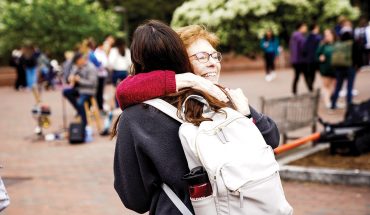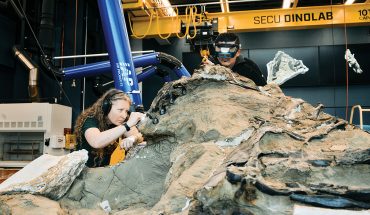photographs by Missy McLamb
Dr. Alper Bozkurt is so earnest, eager to share, and gentle in his manner that one wouldn’t necessarily peg him as the star of an international media frenzy. But CNN, El Mundo, Reuters, the Los Angeles Times and others have all sought out the N.C. State assistant professor of electrical engineering and featured his work at N.C. State’s ibionics lab. That’s where he and a team of graduate students turn live Madagascar hissing cockroaches into insect cyborgs that move and work on human command.
This groundbreaking work involves fitting cockroaches with tiny metal backpacks that receive a remote command from joystick-wielding researchers. Stimulating the insect’s right or left antennae creates a sense that it is being pursued, and forces the cyborg to move in the opposite direction.
One of the most interesting practical implications of his work, funded in part by the National Science Foundation, is the possibility of sending a swarm of these cyborgs into earthquake rubble or other disaster zones to find survivors and record information about conditions. The insect swarms would be able to cover an area from end to end, and because cockroaches are virtually indestructible and practically immune to environmental hazards (as many Raleighites can attest), they are perfectly suited to such a hazardous mission. Cockroaches also have no pain receptors, or neural circuits for pain.
You don’t have to go to Bozkurt’s lab to see them in action. Videos posted on the N.C. State website and also on YouTube feature his cyborgs (or “biobots” as Bozkurt calls them) racing along a thin, winding path, and reveal just how minutely Bozkurt is able to control their movements.
One might think scientists could build their own insect robots from scratch, but Bozkurt, 34, says it is difficult to improve upon the machine Mother Nature created. Bozkurt calls replicating an insect’s complicated anatomical structure “almost impossible.” Better to appropriate the amazing machinery already in place.
Bozkurt first began this research by exploring how humans train larger animals like horses, for example, to move in a certain way. As a rider prods a horse with boots and reins to turn left or right, could a scientist “train” an insect to follow a particular path by manipulating its antennae? His research says yes.
Great for research
Bozkurt began this work here two years ago. When he came to interview at N.C. State for the weekend, “I fell in love,” he says. He was attracted to “the climate, the diverse cultural environment, the proximity to the ocean and mountains,” as well as “big city conveniences.” He says it’s a great place to raise a family, and “a great place to do research.” He also appreciates Raleigh’s proximity to Washington, D.C., where Bozkurt travels regularly to speak with program directors and scientific panels of the National Science Foundation.
Disseminating his findings represents an important part of his job, and so is educating the wider community. Bozkurt and his students brought their work to the North Carolina Museum of Natural Science’s Bugfest this fall, and he also makes time to talk to local student groups, most recently at Ligon Middle School.
Bozkurt’s own interest in science began at a young age. Growing up in Northern Turkey near the Black Sea, he was fascinated by the way bodies work, and considered going into medicine. Ultimately, though, he found a way to marry that interest with his passion for engineering by pursuing studies in biomedical engineering. While in graduate school he met and married his wife, Tuba, also a Turkish national. They are the proud parents of 3-year-old Layla.
Several months ago, when the family moved into a house of their own in Raleigh, they were surprised to find their neighbors were another Turkish family. The serendipity of moving next door to fellow countrymen delights him, as does the diversity of Raleigh in general. “Everywhere you see Europeans, Middle Easterners, Asians, living and working together.” This rich ethnic mixture is something he wants his young daughter to experience and appreciate.
He encourages his students in much the same way. For their benefit, he keeps in his office a map of 100 medical and biotech research organizations where they can do important work and might ultimately be interested in working. Each company appears as a numbered red dot on the background of green.
It’s a map of the Triangle.




